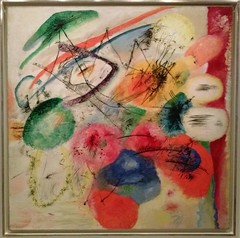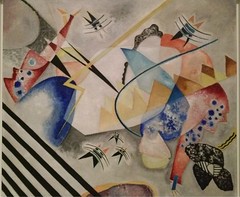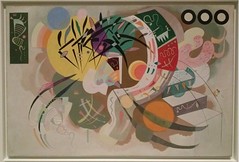 Chopin's Raindrop Prelude, a version that plays over and over for over an hour. It distills and promulgates my mood, distinctly trickling piano keys pour down on my senses, my spirit is changing. I know I'm going to do research on Beethoven's uplifting Fifth Symphony or anything Wagner, I enjoy it all. Strauss, it's like a landscape far away, and Don Juan is a legendary character with a fitting score.
Chopin's Raindrop Prelude, a version that plays over and over for over an hour. It distills and promulgates my mood, distinctly trickling piano keys pour down on my senses, my spirit is changing. I know I'm going to do research on Beethoven's uplifting Fifth Symphony or anything Wagner, I enjoy it all. Strauss, it's like a landscape far away, and Don Juan is a legendary character with a fitting score.
Yet I'm still brooding. I've already read some of the current events of guest conductor Gustavo Dudamel. I was
 intrigued to find out that he was the inspiration for the role of the conductor in the show Mozart in the Jungle, for which I've seen all the episodes at least 3 times, they are just that good. It's the music that keeps taking me back. I re-watch the episode with Dudamel's cameo, he's backstage at the Hollywood Bowl as the stage manager. Ironically, he tells guest conductor Rodrigo: "..you are coming here to conduct. You have to come here. Save us please. We hate our conductor." "Really." "Ugh." And in real life Dudamel is the conductor of the L.A. Philharmonic. I didn't get that the first time I saw the scene. :)
intrigued to find out that he was the inspiration for the role of the conductor in the show Mozart in the Jungle, for which I've seen all the episodes at least 3 times, they are just that good. It's the music that keeps taking me back. I re-watch the episode with Dudamel's cameo, he's backstage at the Hollywood Bowl as the stage manager. Ironically, he tells guest conductor Rodrigo: "..you are coming here to conduct. You have to come here. Save us please. We hate our conductor." "Really." "Ugh." And in real life Dudamel is the conductor of the L.A. Philharmonic. I didn't get that the first time I saw the scene. :)
Now it's Friday and I'm at Heinz Hall. Guest Conductor Gustavo Dudamel enters the stage at Heinz Hall to great
 applause. With raised arms he gestures three curly motions of both hands to signal the Pittsburgh Symphony Orchestra to rise. All throughout the evening we see the same response from Dudamel, he seems less inclined to take the spotlight alone, always immediately bringing the players to their feet. After each piece, he dives deep into the rows of the members to pay tribute to individual players and whole sections. After the Beethoven, he even separates the cellos and violas from the violins, they rise first, right next to the conductor, then the violins last. He steadfastly remains back with the musicians, they all face the audience for their applause together. This seems to be his style. After the final Brahms Hungarian Dance encore, flowers are brought out for Mr. Dudamel. He accepts them, but takes out individual roses and gives them to the female members of the orchestra closest and all the way back to the woodwinds. He even gives a green flower to a male member to great smiles.
applause. With raised arms he gestures three curly motions of both hands to signal the Pittsburgh Symphony Orchestra to rise. All throughout the evening we see the same response from Dudamel, he seems less inclined to take the spotlight alone, always immediately bringing the players to their feet. After each piece, he dives deep into the rows of the members to pay tribute to individual players and whole sections. After the Beethoven, he even separates the cellos and violas from the violins, they rise first, right next to the conductor, then the violins last. He steadfastly remains back with the musicians, they all face the audience for their applause together. This seems to be his style. After the final Brahms Hungarian Dance encore, flowers are brought out for Mr. Dudamel. He accepts them, but takes out individual roses and gives them to the female members of the orchestra closest and all the way back to the woodwinds. He even gives a green flower to a male member to great smiles.
At intermission and before the concert I tweet my thoughts: Conductor @GustavoDudamel is exciting, his smile is infectious, and the music, @PSOMusicians play the heck out of Tannhäuser. Awe struck!

Shall we characterize the music of Beethoven as old? Gustavo Dudamel insists that misses the point. "It is new and creative every time we play it," Dudamel says. "Art is alive all of the time."
That gave me an idea. To listen to Ludwig Beethoven's Symphony no 5 played by the Pittsburgh Symphony Orchestra at Heinz Hall intently searching for those alive variations and enhancements that differ from other performances I've heard and will hear as I try to search for those creative nuances alluded to by the conductor. Whether it be tempo, rhythm or any other colorful accents or artifact that enhance or differentiate, I'd like to glom onto this distinction and bring it to this blog. As I listened, it seemed to me to be distinct from any other Beethoven 5 in that the rhythm seemed different. Parts or sections of instruments seemed to run into each other, as if scurrying around like chipmunks after acorns. But the structure was there, it was intact, the new aspect could be my imagination, but it felt newer, better, brighter somehow.
On the way home I listened to the Pittsburgh Symphony and Manfred Honeck CD I got about a year ago to try to compare. I found it difficult to listen to after hearing it live. The same orchestra, yet in a car the dynamic range either blasts my ears, or is too quiet to hear. At Heinz Hall those range and sound differences are welcomed by my ears and my mind. Bottom line: listen to it live. And while you are listening, be thankful for your sense of hearing.
Today it is Saturday and it is sunny and warm. The music really does make all the difference in the world!
Rodrigo: "I'm about the magic. I'm about the magic, okay?" "Just don't tell me I'm about the glory."








